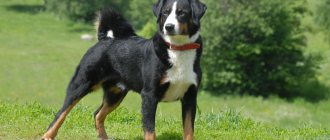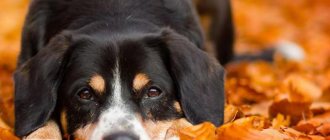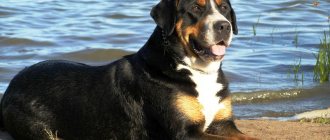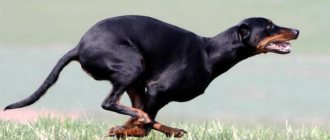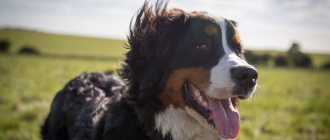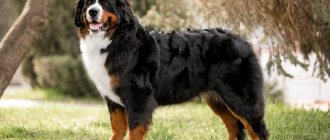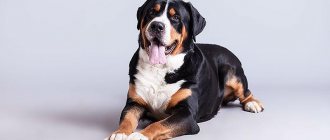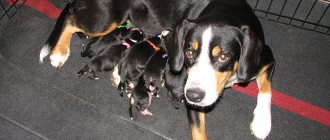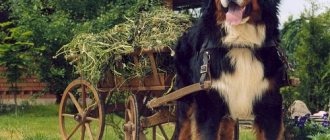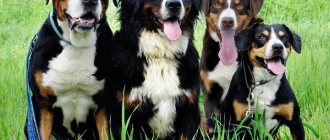Cheerful and affectionate, self-confident and smart, active and sociable - if you are looking for a dog with these characteristics, then the Appenzeller Mountain Dog is the one for you. He is very trainable. But there is one feature - the tendency towards dominance inherent in the breed. A dog needs a powerful, strict, but fair owner. If the attitude is too soft and lack of education from an early age, the puppy will grow into a real bully.
- 2 Table: breed requirements according to the official FCI
2.1 standard Photo gallery: Appenzeller appearance
Breed standard and description
Height at withers: males – 52-56 cm, females – 50-54 cm Weight: 22-32 kg
Color: tricolor, the main color is black or dark brown with tan and white markings in certain places.
- Eyes: brown
- Nose: black or dark brown
- General appearance: compact dog with strong bones and moderately pronounced muscles.
- Moves in a balanced manner.
- Wool with a thick undercoat and a medium-length outer coat.
- The tail must be curled tightly over the croup.
Distinctive features
The Appenzeller Mountain Dog is not like other dog breeds; it has its own distinctive features:
- The body has a strong body.
- The head is proportional in shape, the skull is flat. Cheekbones are poorly defined.
- The bite is scissor-shaped.
- The eyes are small, almond-shaped, and have a smart look and a mischievous expression. Among the characteristic colors there are only black or brown.
- The ears are usually triangular in shape with a rounded part downwards, the base is wide, located close to the cheeks.
- The tail does not exceed medium size, it is low set, and due to its good curl, there is no visible hole in the center. During movement of an individual, the tail falls over the back or to the side.
- The coat is divided into two layers. The upper spine has good density, there is a shine on the surface, sometimes there is a slight waviness, it occupies the area of the withers or back. The bottom layer consists of black color, in addition there is brown and also gray, usually it is not visible through the awn.
History of the breed
The second name is Appenzell Shepherd Dog. The breed received its name because of its original habitat - the city of Appenzell, located in northeastern Switzerland. The second part of the name comes from the word “senn”, as shepherds were called in the Swiss mountains. The Rottweiler is considered a fairly close relative of the Appenzeller.
According to dog experts, the origins of the breed are the Tibetan mastiff, which became the ancestor of the European Molossians. Before being classified into a breed group, these herding dogs were called “bow dogs.” Subtypes then formed and spread throughout the territory of modern Switzerland. This is how the Bernese, Entlebucher and other Sennenhunds appeared.
The executive appenzellers served as cattle dogs . They helped herd the animals and urged those who were lagging behind. In settlements, they were left to guard the house so that they could warn of incoming guests or strangers. They did not expect serious protection from the Appenzellers, but their sensitivity allowed them to be on guard all the time. They were often harnessed to small sleighs. The dogs had excellent endurance and could pull loads along mountain trails .
This breed was first mentioned in the 1853 book Animal Life in the Alps. After 40 years, breeding work began. Enthusiast Max Sieber obtained financial assistance in the amount of 400 francs from the Swiss Cynological Society to maintain the population of Appenzeller Mountain Dogs.
Then there were successful debuts of Appenzellers at exhibitions in Alstatten and Winterthur, the first victories at international events. In 1906, Professor Albert Heim became one of the organizers of the Appenzeller Sennenhund Club. He also created the first version of the breed standard in 1914.
Since the founding of the club, all litters have been registered in one book. The goal of the breeders of that time was to breed purebred dogs, excluding foreign blood impurities. At the same time, it was important to preserve the livestock and quality of assistants to the Swiss peasants.
The Appenzeller Mountain Dog is not a very popular breed today, but its representatives live on both sides of the Atlantic Ocean. Today it is not only the favorite dog of the inhabitants of alpine villages, but also a wonderful companion. The Appenzell Cattle Dog has shown excellent results during rubble rescue operations after accidents in densely populated cities and in mountainous areas.
Price
The price of an Appenzeller without defects, strictly corresponding to the breed standard, with a pedigree and all the necessary documents usually varies in the range of 60-70 thousand rubles in the nursery.
Purchasing an animal with such characteristics makes sense if the owner is determined to contribute to the development and preservation of the natural characteristics of the breed and has every opportunity to properly care for the dog (experience working with dogs is desirable).
Otherwise, it is better to take a puppy with different levels of culling, the cost of which starts from 5 thousand rubles. When buying a puppy of this category, you need to pay special attention to the condition of the hind legs (the breed is characterized by dysplasia), general compliance with the standard, the presence of character manifestations characteristic of the breed (general friendliness, but wary attitude towards strangers, intelligence, quick wit, etc.)
Appenzeller Mountain Dog and man
The Appenzeller Mountain Dog is suitable for almost everyone . Despite their size, they easily fit in a small apartment and do not show hyperactivity. beginners can handle them . However, the best occupation for an Appenzeller is real work, which consists of herding and guarding. These dogs are capable of guarding territory and barking at strangers. Ideal for keeping on a farm .
Appenzellers can live both in an apartment and in a private house on the street. Like many pets of this size, they take up little space in the home, but follow their owner everywhere. It is still advisable to keep them on a personal plot with free range in a fenced area with a good-quality booth and aviary.
These Sennenhunds do not show aggression towards children. Cats and other pets can be protected and herded into a “herd.” Be careful with small animals.
Character
The description of the breed in terms of character and temperament necessarily mentions excellent companion qualities in symbiosis with intelligent guard dogs: Appenzellers are not aggressive, but moderately vicious, and behave warily only when there is a reason for this. That is, the owner can be sure that if his dog barks, then something happened. Empty dogs are not found among well-mannered dogs. The character is playful and playful, this must be kept in mind. The Appenzeller will not, like the phlegmatic breed, lie in its corner. He needs communication and understanding, he perceives a person as a companion, friend and playmate.
The characteristics of the breed exclude aggressiveness. If the quality is revealed, then it is an absolute disqualifying defect.
All these qualities made the Appenzeller indispensable in the role of a rescuer: these dogs search for people under rubble, in the snow after avalanches like St. Bernards and in other similar emergency circumstances. But they cannot be guide dogs - their temperament does not allow it.
Maintenance and care
Conditions of detention
Appenzellers can be kept in a kennel or enclosure . Representatives of the breed need the attention of the owner, but will not require constant games or activities. They are independent, so it is enough for them to observe a person from afar.
heat or cold with precipitation without problems . This is due to the origin and living conditions in the Alps. Even a heavy downpour cannot wet wool of this structure.
They have a standard walk - 2 times in apartment conditions, more often with puppies. If the dog lives on a personal plot, then regular walks are also necessary, but once a day is enough.
From time to time, Appenzellers need to be loaded with various games, duties, and training. For example, on weekends, go to the field and provide physical activity. In some cities, livestock pens designed for herding dogs are available.
Feeding
Approximate diet:
- Beef, offal – daily
- Cottage cheese, fermented baked milk, kefir – periodically
- Steamed rice, buckwheat – daily (about 20% of one serving)
- Raw egg – 1-2 times a week
- Vegetables and fruits – seasonally and periodically
During the period of active growth, Appenzellers are given mineral supplements in their food and fed with vitamins. Ready-made food is selected according to the size, age, health and activity of a particular dog, as well as the portion.
Grooming
minimal coat care . The current breed standard does not provide for haircuts or trimming, so it is enough to wash the pet when it gets dirty and brush it several times a month (more often during shedding).
There should be no plaque on the ears of a healthy dog, but for prevention, you can treat the shell with special drops or a cotton pad soaked in a small amount of hydrogen peroxide. The claws are trimmed if they do not grind down on their own.
Today, cleaning teeth from tartar in veterinary clinics is very popular, but in order to prevent its occurrence, it is necessary to give the Appenzeller Mountain Dog large beef bones, raw cartilage, turkey necks, and delicacies from the veins.
Nutrition
One of the most difficult and controversial issues in keeping a dog is proper feeding. Dry food or natural, overfeeding and underfeeding, is it possible to give carbohydrates, and if so, in what quantity?
When feeding Appenzellers, many similar questions arise, to which, perhaps, no one can give a definite answer except the dog owner himself and, perhaps, a veterinarian.
When developing a menu, it is necessary to take into account a number of factors: the dog is kept in the house (where the temperature is higher and there is no opportunity to spend calories on heating) or on the street; is it possible to feed natural meat, which is as natural as possible for these animals; what level of physical activity is provided to the dog and, accordingly, how many calories it needs per day.
These and many other nuances leave their mark on feeding decisions. And in each individual case the decision must be made individually. As part of general recommendations, we can recommend the following:
1. The puppy should not be overfed, otherwise in adulthood there will be problems with its paws.
2. The volume of natural food up to 6 months of age is 7% of body weight, after six months the volume is halved.
3. The entire amount of food should be given in 2-3 doses per day.
4. The diet should include meat, offal, and dairy foods. It is advisable to give plant foods: cabbage, carrots, apples, salad, etc. products that contribute to the formation of normal microflora.
5. If the dog leaves even a small amount of food in the bowl, the diet should be reduced. The same should be done if the appenzeller eats only what he likes and leaves the rest in the bowl.
6. After your dog eats, try giving him a little more. If the dog is fed properly, he will not refuse. Ideally, after eating, the Appenzeller should remain a little hungry; overfeeding or constantly feeding to the point of satiety is strictly not recommended.
7. Be sure to give vitamins. The only exception is when the pet is fed high-quality dry food and additives are included in its composition.
Education and training
The herding dog learns well and quickly , because for centuries it has performed a variety of work. In modern conditions, they engage in such a sport as agility. Sometimes they can be found on the protective guard service (PSS) course, but the Appenzellers do not achieve much success with the person involved.
They begin to train from childhood. From about 2-3 months, they teach the simplest commands: “sit”, “come towards me”, “no”. Physical strength will not help in raising an adequate animal, but will only give rise to fears and causeless aggression with cowardice.
First of all, the pet is motivated . There are so-called “food workers” who are prone to gluttony and are ready to work with all their might for a piece of delicacy. It is very easy to establish contact with them. They try different techniques with other dogs. Effective ways are to engage the child in a game, give him a favorite toy, and reward him with strokes after successfully completing a command. Sometimes a clicker device helps. Puppies also adopt the experience of their adult relatives, learning from their example.
From the first days of the Appenzeller Mountain Dog's stay in a new home, it is important to show who is the leader in the pack. The dog should be at the lowest level in the hierarchy after all family members. This does not mean that it is necessary to suppress it, but the owner is obliged to be strict and consistent in his actions.
Possible diseases
Genetically, the breed is quite resistant to diseases, physically hardy and healthy. But when kept in an apartment with limited street exercise, unpleasant phenomena such as allergic reactions (to detergents, for example), conjunctivitis (reaction to dry air), obesity (lack of movement), skin problems (improper care, overheating) and so on may occur. Further. In all cases of doubt about your pet’s health, you should contact a veterinarian who can prescribe treatment appropriate to the medical case.
Health and life expectancy
Appenzellers live on average 12-14 years . Given the average size, this is a good indicator. In addition, breeders secretly try to use exclusively dogs from long-lived lines for breeding.
This breed is generally healthy. The following common diseases are noted:
- Hip dysplasia,
- retinal atrophy,
- Kidney diseases,
- Congenital anomalies of the ureters,
- Volvulus,
- Osteosarcoma,
- Dislocation of the kneecap,
- Heart disease.
Before mating, all dogs are tested to determine whether they are carriers of genetic diseases. Additionally, research is being conducted to avoid the appearance of long-haired puppies, which is considered a disadvantage. Perhaps the long hair appeared due to the influx of Newfoundland blood into Appenzell dogs several decades ago.
Advice on choosing a purebred puppy
When choosing an Appenzeller puppy, make sure that it meets all the appearance and character standards listed in the article. Any deviations from the required parameters will be grounds for refusal of the certificate required for participation in exhibitions and mating with purebred partners.
This is what an Appenzeller puppy looks like at 1 month
The breed is quite rare in our country. This determines the high price for puppies. On average, Appenzeller dogs cost from 60,000 rubles. But this is the price for a dog of the “breeding” category (does not have breeding registration, is not suitable for purebred breeding). If the puppy is a show class (meets all standards, parents have won prestigious exhibitions, purebred proven by several generations), then the cost can be more than 120,000 rub.
It is better to purchase a puppy through nurseries. In Russia, the following people specialize in the Appenzeller Mountain Dog breed:
- "Vingenium" (Moscow),
- "Royal Pappy" (Moscow),
- "Splinded Tricolor" (Ufa),
- "Shakesburg" (Cherepovets),
- "Er Senses" (Nizhny Novgorod).
Among foreign nurseries, the Finnish Alpenhirts is considered the most authoritative.
Breed photo
A selection of photos of Appenzellers.
Advantages
Among the main advantages of the breed are loyalty and affection . The dog is an excellent watchman and security guard who is not afraid of anyone. The dog does not need special care, basic care is enough.
Advantages of the breed:
- equilibrium;
- confidence;
- instant response;
- devotion.
The pet is not just an excellent guard, but also a devoted watchman. A stranger will not move through its territory. The dog will quickly pay attention to him and will drive him out of his place with all his might.
Flaws
- Among the disadvantages, severe shedding stands out. The pet must be constantly brushed due to the rapid change of hair, otherwise the dog will become restless.
- Appenzellers must be subjected to constant physical activity . If this is not done, they may get sick and become unsightly.
Differences from Entlebucher
The main difference between these breeds is size. The Entlebucher Mountain Dog is noticeably smaller than the Appenzeller , and therefore may be better suited for a city apartment than its larger “relative.” For a private house and, especially, a farm, a larger appenzeller is much better suited.
Appenzeller/Bernski/Gross/Entlebucher
Mating
In order for future puppies to receive all pedigree documents, the mating of the parents must be planned. Bitches are ready for fertilization already at the first estrus at 8-10 months, but to preserve their health it is recommended to breed not earlier than the second, and preferably the third, estrus, that is, not earlier than 2-3 years. Males can also mate a bitch as early as adolescence, but full puberty occurs by 1.5 years.
If possible, the dogs are introduced in advance, and this is done on neutral territory. If the bitch is shy and does not allow the male dog to approach her, then the “wedding” can be held on the bitch’s territory so that she does not experience unnecessary stress from a change of environment. But under normal circumstances, mating takes place in the dog’s territory, where he feels more confident - the owners argue that this is more important, because a dog ready for mating can cope with even an inexperienced bitch.
Animals are bred not on the first day of estrus, but on days 10-12 from its onset. Control mating takes place the next day or the next day; this is not necessary, but will give a greater chance of fertilization. The owner of the bitch pays for the mating with a future “alimony” puppy or money equivalent to the cost of the puppy.
Application
A universally applicable breed: herd dog, sled dog, service dog, guard dog, sports dog, companion dog.
Initially, Swiss Mountain Dogs were used as shepherds, herd guards, helping to protect livestock, when driving them into stalls, and when moving between meadows. This was their main task, which they did very well. At the same time, they were used in rescue operations, when it was necessary to deliver water or medicine to people under mountain rubble or in remote pastures.
With the development of technology, Swiss “shepherds” as cattle dogs ceased to interest people. Today, Appenzeller Mountain Dogs are kept primarily as domestic companions, including in families with small children.
Interesting Facts
- The Appenzeller brand is very popular in Switzerland. Without thinking twice, she also named a breed of chicken and cheese. Therefore, the prefix “Sennenhund” is very useful if you are looking for a dog.
- The Swiss Appenzeller is the only Sennenhund that, according to the standard, is allowed not only black, but also chocolate color as its base color. In this case, the undercoat is allowed to be gray, fawn or standard black.
- The Appenzeller Mountain Dog is distinguished by its incorruptibility. Under no circumstances will a dog take a treat from someone else's hands. You can be sure that with such a security guard you will be safe.
Kinds
Sennenhunds are a group of dogs native to Switzerland. In addition to our hero, three more famous breeds are known. Greater Swiss Mountain Dog. Once an extremely sought after breed among Swiss shepherds. Descendant of imported mastiffs and local dogs. A large, strong animal with a heavy skeleton.
The Greater Swiss Mountain Dog has a balanced character and versatile working qualities.
At the withers up to 72 cm, weight up to 64 kg. The color is standard for herding dogs - black, white and red. The coat is hard and not long. They were often used to transport goods and people. Two harnessed dogs could pull the cart behind them. But the dog was not agile enough for farm work, so he was gradually replaced by other breeds and machines.
Bernese Mountain Dog. His native place is near the city of Bern. After several centuries of spontaneous breeding, in 1902 one specimen was presented at a famous exhibition. And the Swiss seemed to have their eyes opened - already in 1907 a standard was set for them, a club was organized, and in 1910 107 purebred dogs were presented to the public.
The coat color is not original - black with white and red. But the structure of the fur is completely different - long, shiny, silky hair. This was probably due to the Newfoundland genes that were added in 1949. Standard height is 63-68 cm, weight 48-50 kg.
The Bernese Mountain Dog is a gentle and charming giant, unusually peaceful
Entlebucher Mountain Dog. If you place all the Mountain Dogs in a row, then the first in height is the Greater Swiss, and the last in the line is this dog. He is the smallest of all. Height up to 50 cm, weight approximately 25 kg. Need I say that the color is no different?
The same black, white and red color scheme. And, despite his size, and perhaps precisely because of this, he is the most temperamental of all. If the big brothers, aware of their status, are distinguished by confident calm and good nature, the smallest is full of energy and always on the alert.
If you are looking for a pet with whom you can share an interest in sports records, then this is the Entlebucher.
Dog names
Choosing a nickname for energetic and restless Appenzeller Mountain Dog puppies is both simple and difficult at the same time. Below are a few examples of nicknames that may suit your pet. Names for a male: Bekar, Zyuzya, Gerard, Quent, Daysan and so on. For a female: Zemira, Nora, Clyda, Pitti, Bonya and the like.
Despite the fact that Appenzellers' coat changes year-round and sheds twice a year, caring for them is not difficult. You can purchase a special glove or brush and periodically run it over the dog’s body. In this way, lost hair and dead skin particles will be removed, and it is also a kind of massage that will not harm the dog.
You also need to periodically use various flea products. It is necessary to follow generally accepted rules of hygiene: clean your pet’s teeth, eyes and ears as needed. You need to take care of the claws and trim them if necessary.
As already written above, the Appenzeller will feel better and more comfortable in a country house. When kept in a confined apartment space, it is necessary to provide such an active pet with a long and high-quality walk with the opportunity to run freely without a leash.
It is better to do this on special sites equipped with various obstacles. Also, from an early age, teach a dog living in an apartment to be clean and relieve itself outdoors.
Owner reviews
Believe me, you won’t find negative reviews from the owners of these wonderful dogs all over the Internet:
Alexei:
“Two years ago we became the happy owners of a miracle named Ralph of the Appenzeller Mountain Dog breed, and during all this time we have never regretted that we bought him, and not a Bernese, as we first wanted. Our dog is incredibly smart: he seems to know commands from birth and happily carries them out. He especially loves the “Voice” team, however, this is how they are supposed to be by their breed - shepherd dogs, bark when corralling cows and sheep. And we have an excellent security guard, I must say. And it's a pleasure to walk with him. We also took him on bicycle trips with us, the dog can handle all road difficulties very well. Although no, transfers is not the right word. He just enjoys it all...”
Catherine:
“Several years ago we didn’t even know these dogs existed. And then suddenly they saw him in a book on dog breeding, and that’s it - it was love at first sight. But we learned about how wonderful animals they are, these Appenzellers, only when we got our Bertha. She's just crazy smart. From a half-glance she understands what we want from her, I never remember a case where Bertha refused to carry out some command. You can safely leave her with the children: she will look after them and watch over them, so that no stranger will offend...”
Julia:
“I always dreamed of a dog, but when my husband gave me something strange, black, white and red for my birthday, and even said that it was some kind of Appenzeller that I had never heard of in my life, I was shocked. But Sam, as we named the puppy, literally charmed us not only with his unusual appearance, but also with his intelligence. It’s a pleasure to train him; he remembers all the commands right away. You wouldn't say that Sam is malicious towards strangers, but he is an excellent guard. True, sometimes a mischievous person will steal a slipper or a glove and run with it throughout the apartment, as if teasingly: “Come on, take it away!”...
